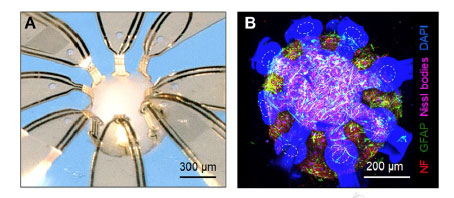Body
A team of scientists, led by researchers at Shirley Ryan AbilityLab, Northwestern University and the University of Illinois at Chicago, has developed novel technology promising to increase understanding of how brains develop, and offer answers on repairing brains in the wake of neurotrauma and neurodegenerative diseases.

Their research is the first to combine the most sophisticated 3-D bioelectronic systems with highly advanced 3-D human neural cultures — the goal to enable precise studies of how human brain circuits develop and repair themselves in vitro. The study is the cover story for the March 19, 2021, issue of Science Advances. The work was supported by a National Institutes of Health Research Project Grant (R01) shared by Colin Franz, MD, PhD, of Shirley Ryan AbilityLab, John Rogers, PhD, and Yonggang Huang, PhD, of Northwestern University, and John Finan, PhD, of University of Illinois at Chicago. It also was supported by a generous philanthropic gift from the family of Belle Carnell, which established a regenerative neurorehabilitation fund for precision medicine in Dr. Franz’s lab.
The cortical spheroids used in the study, akin to “mini-brains,” were derived from human-induced pluripotent stem cells. Leveraging a 3-D neural interface system that the team developed, scientists were able to create a “mini laboratory in a dish” specifically tailored to study the mini-brains and collect different types of data simultaneously. Scientists incorporated electrodes to record electrical activity. They added tiny heating elements to either keep the brain cultures warm or, in some cases, intentionally overheated the cultures to stress
them. They also incorporated tiny probes — such as oxygen sensors and small LED lights — to perform optogenetic experiments. For instance, they introduced genes into the cells that allowed them to control the neural activity using different-colored light pulses.
IMPACT: “The advances spurred by this research will offer a new frontier in the way we study and understand the brain,” said Shirley Ryan AbilityLab’s Dr. Franz, co-lead author on the paper who led the testing of the cortical spheroids. “Now that the 3-D platform has been developed and validated, we will be able to perform more targeted studies on our patients recovering from neurological injury or battling a neurodegenerative disease.”
- Dr. Franz and his collaborators have secured a $3 million grant from the National Institutes of Health to support follow up studies related to this project.
- Over the past 12 months this study has been downloaded from Science Advances website >7,500 times and cited in 8 other peer reviewed articles.
- Storied have been written about it in over 10 different news outlets including Bioengineer, La Opinion De Malaga, and Neuro Central to name a few.
